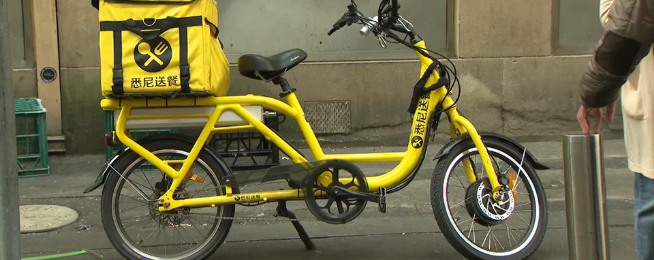The food delivery e-bikes that peculiarly zip around the city with the riders’ legs frozen stiff, may soon be banished from the bike lanes.
The machines were effectively electric motorcycles, with the pedals rarely pushed.
But now they are on the way out, and food delivery riders will in the future share healthy, elevated heart rates with the rest of us.
A quirk in the rules has permitted electric bikes with 200 watts of power to have a throttle grip. But the exception, understood to have been created for Australia Post, created a loophole big enough for a food delivery to slip right through.
Queensland is the first state government to make the change.
Queensland laws require a bike, including power-assisted ones, to use pedals as the primary source of power.
The electric motor or motors on those types of bikes are only meant to assist the rider to pedal.
Most normal e-bikes adhere to this standard, known as the Pedelec standard. The electric assistance only flows when you are peddling, and it cuts out at 25km/h.
There is no reason that all e-bikes, including Australia Post and food delivery bikes, should not conform to this standard.
Acting Queensland Transport and Main Roads Minister Steven Miles said the changes addressed concerns about illegal electric, moped-like vehicles being hired and sold on the Gold Coast as power-assisted bicycles.
“There has been a series of complaints on the Gold Coast about these high-powered mopeds putting pedestrians and riders at risk,” Mr Miles said.
“What police are seeing on the Gold Coast are mopeds that can travel up to 40km/h, completely under the power of the motor, with no pedalling needed,” Mr Miles said.
“High-powered mopeds and motorcycle-like devices donʼt belong on our footpaths so what weʼve done is clarify our laws to better define what is legal and what isnʼt when it comes to power-assisted bicycles."
Mr Miles said there needed to be a clear distinction between pedal- operated devices and a throttle-operated moped or a motorcycle, which must be registered for road use.
The rule changes came into effect on 28 June 2019.
Other states are expected to follow.
Industry group Bike Industries Australia is understood to welcome the changes as long as there is a six months grace period for importers and operators to comply.
The food delivery industry has boomed in the inner suburbs of the major cities and has resulted in a substantial increase on bikes on the street.
It is a forerunner of many other innovations in logistics that lie ahead, as congestion and pollution limit the use of the now ubiquitous diesel van.
This a positive trend that should be encouraged, and technology and good regulation will play a part.
Bike lanes are for active transport and should never be used for 100 per cent powered vehicles.
We look forward to other states closing the throttle grip.
Read more: the reverse traffic pyramid that prioritises physical activity
Become our friend
Find out more about Bicycle Network and support us in making it easier for people to ride bikes.


